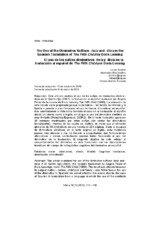Mostrar el registro sencillo del ítem
The Use of the Diminutive Suffixes -ito/a and -illo/a in the Spanish Translation of The Fifth Child by Doris Lessing
| dc.contributor.author | Bourne, Julián | |
| dc.contributor.author | Díaz Dueñas, Mercedes | |
| dc.date.accessioned | 2020-02-05T09:15:17Z | |
| dc.date.available | 2020-02-05T09:15:17Z | |
| dc.date.issued | 2019 | |
| dc.identifier.issn | 1579-9794 | |
| dc.identifier.uri | http://hdl.handle.net/10396/19475 | |
| dc.description.abstract | Este artículo analiza el uso de los sufijos de diminutivo -ito/a e illo/a en El Quinto Hijo (2001), la traducción al español realizada por Ángela Pérez de la novela de Doris Lessing The Fifth Child (1988). La selección de esta novela viene propiciada porque su temática – los bebés, la infancia y la familia – parecía a priori favorecer el uso de formas diminutivas en español. Nos cuestionamos si éste sería también el caso en la traducción al español desde un idioma como el inglés, en el que el uso del diminutivo sintético es muy limitado (González-Espresati, 2008:2). En el texto traducido aparecen 35 nombres modificados por estos sufijos (sin contar los diminutivos lexicalizados), muchos de los cuales se repiten, de modo que el cómputo global es de 69 diminutivos en una novela de 224 páginas. Dada la escasez de diminutivos sintéticos en el texto original en inglés, esta incidencia parece muy elevada y nos ha llevado a preguntarnos qué formulaciones alternativas o claves contextuales puedan haber favorecido el uso del diminutivo en la traducción. El segundo objetivo ha sido cotejar el comportamiento del diminutivo en esta traducción con las descripciones teoréticas del campo de la lingüística cognitiva del diminutivo en español. | es_ES |
| dc.description.abstract | This article examines the use of the diminutive suffixes -ito/a and illo/a in El Quinto Hijo (2001), the Spanish translation by Ángela Pérez of Doris Lessing’s novel The Fifth Child (1988). The novel was chosen because its subject matter – babies, childhood and family – was felt to favour the use of the diminutive in Spanish; we asked whether this would also be the case of Spanish in translation from a language in which the use of the synthetic diminutive is severely restricted (González-Espresati, 2008:2). The translated text presents 35 nouns modified by these suffixes (not counting lexicalized diminutives), many of which are repeated, so that the total incidence is 69 in a novel of 224 pages. Given the scarcity of synthetic diminutive forms in the English text, this incidence seems quite high and led us to enquire what alternative formulations or contextual cues may have given rise to the use of the diminutive in the translation. A second objective was to compare the behaviour of the diminutive in this translation with the theoretical descriptions of the diminutive in Spanish from the field of cognitive linguistics | es_ES |
| dc.format.mimetype | application/pdf | es_ES |
| dc.language.iso | eng | es_ES |
| dc.publisher | UCOPress | es_ES |
| dc.rights | https://creativecommons.org/licenses/by-nc-nd/4.0/ | es_ES |
| dc.source | Hikma 18(1), 113-180 (2019) | es_ES |
| dc.subject | Diminutivos | es_ES |
| dc.subject | Afecto | es_ES |
| dc.subject | Modelo Cognitivo Idealizado | es_ES |
| dc.subject | Denotación | es_ES |
| dc.subject | Connotación | es_ES |
| dc.subject | Diminutives | es_ES |
| dc.subject | Affect | es_ES |
| dc.subject | Idealized Cognitive Model | es_ES |
| dc.subject | Denotation | es_ES |
| dc.subject | Connotation | es_ES |
| dc.title | The Use of the Diminutive Suffixes -ito/a and -illo/a in the Spanish Translation of The Fifth Child by Doris Lessing | es_ES |
| dc.title.alternative | El uso de los sufijos diminutivos -ito/a y -illo/a en la traducción al español de The Fifth Child por Doris Lessing | es_ES |
| dc.type | info:eu-repo/semantics/article | es_ES |
| dc.relation.publisherversion | https://www.uco.es/ucopress/ojs/index.php/hikma/index | es_ES |
| dc.rights.accessRights | info:eu-repo/semantics/openAccess | es_ES |

